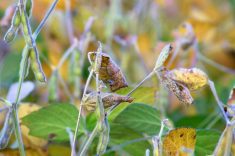If there’s an answer to soybean cyst nematode, it may lie in the soybean family tree.
Soybean cyst nematode (SCN) has been a tough problem since it first appeared in North America back in the 1950s. It’s a soil-bound pest so it can’t be sprayed.
Instead, the solution must be found through biology—finding a weak spot to use to farmers’ advantage.
Read Also

Journal pulls long-cited glyphosate study for ethics violations
The journal Regulatory Toxicology and Pharmacology has retracted a 2000 Monsanto-linked glyphosate review, drawing new scrutiny as Bayer faces mounting legal pressure.
Unfortunately, according to University of Iowa plant pathologist Greg Tylka, “there’s been researchers working on it for 50 years.”
If there was an easy chink in the armour, it would have already been found. However, there are still a few possibilities.
Every organism has predators and soybean cyst nematode is no exception. In the soil, it’s preyed upon by strains of fungi, mites and other nematodes. Some have been tried as a form of biological control, although none have been successful.
So far, the best solution is variety resistance, and that starts with serious detective work. The ancestral soybean has been dealing with the soybean cyst nematode for a few million years, so plant breeders have gone back to the source to see how the proto soybean did it.
It turns out that those plants had a cheat code that let them win a few rounds against the nematode.
The game goes like this:
The nematode enters the plant and, once inside the root, inserts a sharp tooth called a stylet into the surrounding cells. The worm then injects a cocktail of hormones and signals the plant to feed it.
Plants with a certain genetic combination are able to detect the damage and play an ingenious defence. They cut the damaged cells from their vascular tissue so they starve, die off and form a tough barrier that isolates the nematode from living plant tissue. The nematode starves and dies.
Soybean breeders found two distinct sets of genetic resistance. Both may be available in seed catalogues, but only one dominates the soybean farmer’s roster.
“Almost every soybean variety ever produced to be grown in Iowa, resistant to SCN, has the same set of genetics for resistance,” Tylka said. “It’s a line called PI 88788.”
Now the nematodes are starting to win a few hands. SCN across Iowa has started to achieve higher reproduction on PI 88788.
The other form of resistance is called Peking and, since it’s rarely used, it’s become the more effective form. The problem with Peking is that the plants with that line are less productive.
The race is on to find another source of resistance that offers the efficacy of Peking and the productive capacity of PI88788.
It’s a cautionary tale for Canada, Tylka concluded.
“Don’t be happy to have one set of resistance genetics available for your farmers. Keep working to develop that second one because that first one will eventually wear out.”















